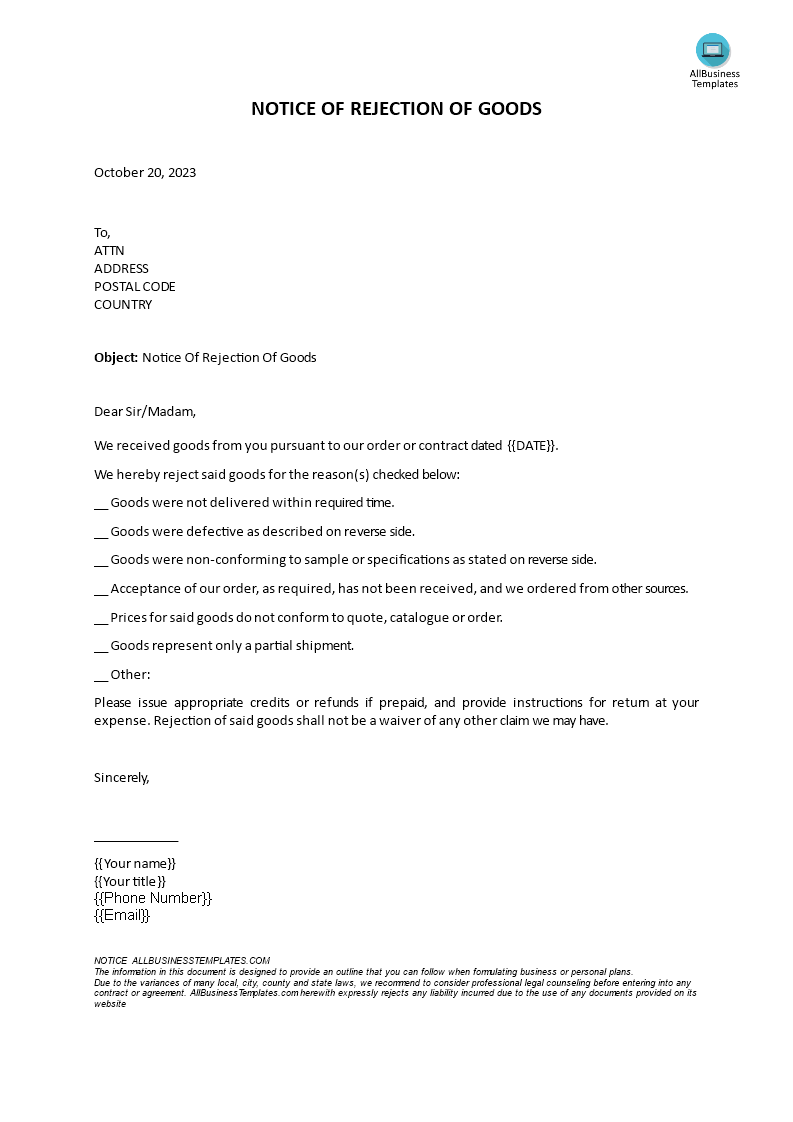Notice Of Rejection Of Goods
Save, fill-In The Blanks, Print, Done!

Download Notice Of Rejection Of Goods
Today: USD 1.99
Download It Now

Available premium file formats:
Microsoft Word (.docx)- This Document Has Been Certified by a Professional
- 100% customizable
- This is a digital download (23.31 kB)
- Language: English
- You will receive a link to download the file as soon as your payment goes through.
- We recommend downloading this file onto your computer.
Do you need a Notice of rejection of purchased goods? How do you interpret notice of rejection? This template can be used to reject goods that do not meet quality standards or that are not in the expected quantity. It can also be used to reject goods that were purchased from an unauthorized supplier. Download this professional Notice Of Rejection Of Goods template now!
The process for the rejection of goods typically involves a series of steps that a buyer or customer follows when they receive goods that do not meet their expectations, are damaged, or otherwise fail to conform to the agreed-upon specifications or terms of purchase. Here is a general process for the rejection of goods:
- Inspection of Goods Upon Receipt:
- Upon receiving the goods, the buyer or recipient should immediately inspect them for any visible damage, defects, or discrepancies from the order.
- Document the Issues:
- If any issues are identified during the inspection, they should be documented in detail. This documentation may include photographs, written descriptions, and any relevant order or shipment numbers.
- Review the Purchase Agreement:
- Refer to the purchase agreement, contract, or purchase order to confirm the agreed-upon specifications, quality standards, and terms of purchase. This step is crucial for assessing whether the received goods conform to the contract.
- Notify the Seller or Supplier:
- Contact the seller or supplier as soon as possible to notify them of the issues with the received goods. This notification should be in writing, such as an email or a formal letter, and should clearly outline the problems and reference the relevant order or contract.
- Request for Resolution:
- In the notification, specify the desired resolution or action you are seeking. Common requests include replacement of the goods, repair of defects, a refund, or a credit to your account.
- Provide Supporting Documentation:
- Attach any supporting documentation, such as photographs, inspection reports, or copies of the purchase agreement, to substantiate your claim.
- Arrange for Return or Inspection:
- Depending on the nature of the issues, the seller may request that the goods be returned for inspection or provide instructions for handling damaged or defective items. Follow their instructions accordingly.
- Communicate in Writing:
- Maintain written communication with the seller or supplier throughout the process. Keep records of all correspondence, including emails, letters, and notes from phone conversations.
- Await Seller's Response:
- Allow the seller or supplier a reasonable amount of time to respond to your complaint and provide a proposed resolution.
- Review Seller's Response:
- Review the seller's response to assess whether it aligns with your requested resolution and whether it adequately addresses the issues.
- Negotiation and Resolution:
- Engage in negotiations with the seller if necessary to reach a mutually acceptable resolution. Be prepared to compromise if appropriate.
- Formalize the Resolution:
- Once an agreement is reached, formalize the resolution in writing. This may involve signing a revised agreement, receiving a credit or refund, or confirming the replacement or repair of the goods.
- Take Action:
- Depending on the agreed-upon resolution, take the necessary actions, such as returning the rejected goods, receiving replacements, or processing refunds.
- Monitor the Resolution:
- Monitor the implementation of the resolution to ensure that it is carried out as agreed. Keep records of any actions taken and payments received.
- Closing Communication:
- Conclude the matter by confirming in writing that the issue has been resolved to your satisfaction. Express gratitude for their cooperation.
It's important to follow a systematic and documented process when rejecting goods to protect your rights as a buyer or customer and to facilitate a smooth resolution with the seller or supplier. If disputes persist, legal advice or mediation may be necessary to achieve a satisfactory outcome.
Download this professional Notice Of Rejection Of Goods template now!
DISCLAIMER
Nothing on this site shall be considered legal advice and no attorney-client relationship is established.
Leave a Reply. If you have any questions or remarks, feel free to post them below.
Rejection Letters
When you write the letter, consider keeping the door open for future possibilities. Maybe the other opportunity, project, or job you accept is not the right fit.
Read moreRelated templates
Latest templates
Latest topics
- Excel Templates
Where do I find templates for Excel? How do I create a template in Excel? Check these editable and printable Excel Templates and download them directly! - GDPR Compliance Templates
What do you need to become GDPR compliant? Are you looking for useful GDPR document templates to make you compliant? All these compliance documents will be available to download instantly... - Google Docs Templates
How to create documents in Google Docs? We provide Google Docs compatible template and these are the reasons why it's useful to work with Google Docs... - IT Security Standards Kit
What are IT Security Standards? Check out our collection of this newly updated IT Security Kit Standard templates, including policies, controls, processes, checklists, procedures and other documents. - Letter Format
How to format a letter? Here is a brief overview of common letter formats and templates in USA and UK and get inspirited immediately!
cheese
